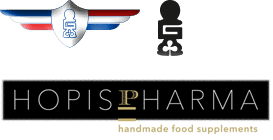Descrizione
CARATTERISTICHE DEL PRODOTTO
La Baicaleina è un flavone naturale (un tipo di flavonoide) che si trova principalmente nelle radici della Scutellaria baicalensis Georgi. Il suo utilizzo è sia da ricercarsi nella Medicina Tradizionale Cinese(MTC) che nella Kampo Giapponese.
INGREDIENTI
• SCUTELLARIA BAICALENSIS GEORGI RADIX E.S. TIT. 85% IN BAICALINA*
• SCUTELLARIA BAICALENSIS GEORGI RADIX E.S. TIT. 98% IN BAICALEINA*
COME UTILIZZARE IL PRODOTTO
1 capsula al giorno a stomaco pieno.
DOSI GIORNALIERE
Scutellaria baicalensis radix 500mg
di cui baicalina 298mg
baicaleina 148mg
FORMATO
60 cps. da 500mg
* materia prima origine CINA
BIBLIOGRAFIA
De Carvalho, R.S.M.; Duarte, F.S.; De Lima, T.C.M. Involvement of GABAergic non-benzodiazepine sites in the anxiolytic-like and sedative effects of the flavonoid baicalein in mice. Behav. Brain. Res., 2011, 221, 75-82. CrossRef DOI: http://dx.doi.org/10.1016/ j.bbr.2011.02.038
-Wang Y. H., Yu H. T., Pu X. P. & Du G. H. Baicalein prevents 6-hydroxydopamine-induced mitochondrial dysfunction in SH-SY5Y cells via inhibition of mitochondrial oxidation and up-regulation of DJ-1 protein expression. Molecules 18, 14726–14738 (2013).
-Liu A. et al. Baicalein protects against polymicrobial sepsis-induced liver injury via inhibition of inflammation and apoptosis in mice. Eur. J. Pharmacol. 748, 45–53 (2015).
-Mabalirajan U. et al. Baicalein reduces airway injury in allergen and IL-13 induced airway inflammation. PLoS One 8, e62916 (2013).
-Guo Z. et al. Baicalein inhibits prostate cancer cell growth and metastasis via the caveolin-1/AKT/mTOR pathway. Mol. Cell. Biochem. 406, 111–119 (2015).
-Georas S. N. & Rezaee F. Epithelial barrier function: At the frontline of asthma immunology and allergic airway inflammation. J. Allergy Clin. Immunol. 134, 509–520 (2014).
-Mabalirajan U. et al. Baicalein reduces airway injury in allergen and IL-13 induced airway inflammation. PLoS One 8, e62916 (2013).
-Lee J. Y., Kim J. M. & Kim C. J. Flavones derived from nature attenuate the immediate and late-phase asthmatic responses to aerosolized-ovalbumin exposure in conscious guinea pigs. Inflamm. Res. 63, 53–60 (2014).
-Yun M. Y. et al. Therapeutic effects of Baicalein on atopic dermatitis-like skin lesions of NC/Nga mice induced by dermatophagoides pteronyssinus. Int. Immunopharmacol. 10, 1142–1148 (2010).
-Kimata M., Inagaki N. & Nagai H. Effects of luteolin and other flavonoids on IgE-mediated allergic reactions. Planta Med. 66, 25–29 (2000).
– Kimata M, Shichijo M, Miura T, Serizawa I, Inagaki N, Nagai H. Effects of luteolin, quercetin and baicalein on immunoglobulin E-mediated mediator release from human cultured mast cells. Clin. Exp. Allergy 2000;30:501- 508.
–Dubravko Jelić, Agnieszka D. Lower-Nedza, Adelheid H. Brantner, et al., “Baicalin and Baicalein Inhibit Src Tyrosine Kinase and Production of IL-6,” Journal of Chemistry, vol. 2016, Article ID 2510621, 6 pages, 2016. doi:10.1155/2016/2510621
–B. Q. Li, T. Fu, W.-H. Gong et al., “The flavonoid baicalin exhibits anti-inflammatory activity by binding to chemokines,” Immunopharmacology, vol. 49, no. 3, pp. 295–306, 2000.
-T. Nagai, R. Moriguchi, Y. Suzuki, T. Tomimori, and H. Yamada, “Mode of action of the anti-influenza virus activity of plant flavonoid, 5,7,4′-trihydroxy-8-methoxyflavone, from the roots of Scutellaria baicalensis,” Antiviral Research, vol. 26, no. 1, pp. 11–25, 1995.






